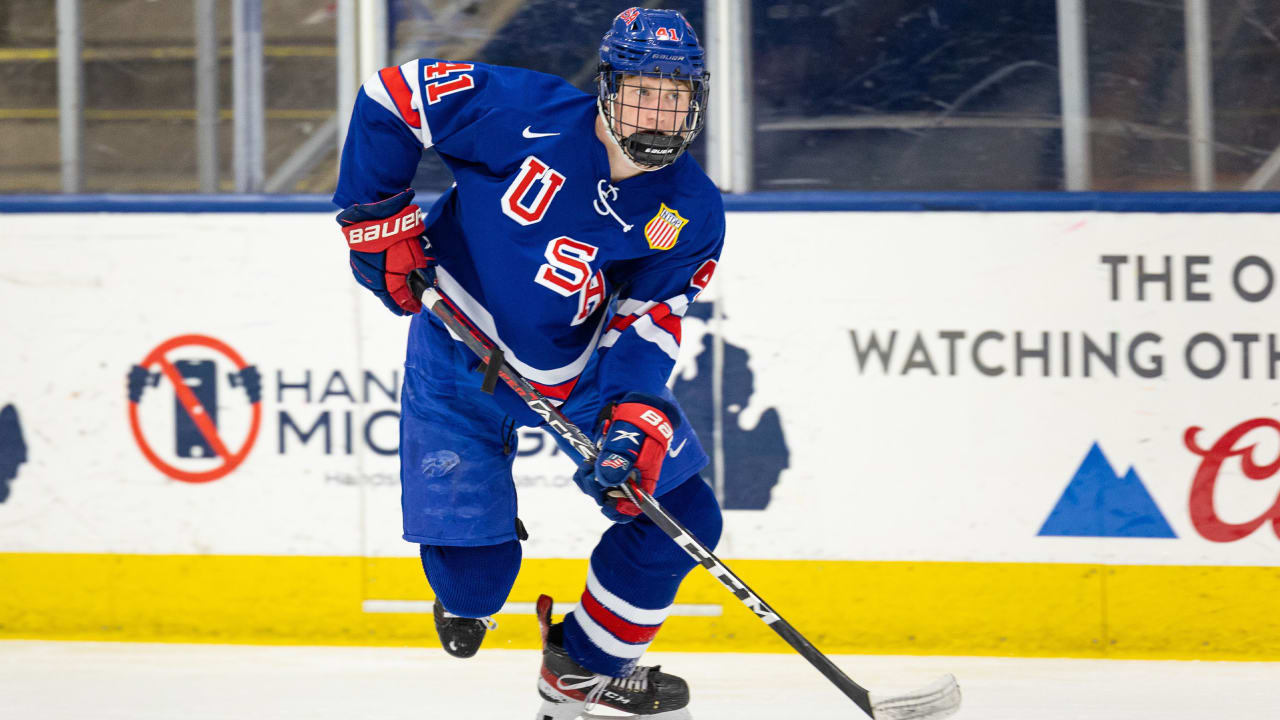Bultman: Let’s move on to our next topic, on a pair of right-shot defenders teams will certainly be deciding between in the coming days: Tom Willander and Axel Sandin Pellikka. Corey, we’ll start with you here, as Willander shot up your final ranks into the top 15, ahead of Sandin Pellikka. Why do you prefer him now?
Pronman: I think Sandin Pellikka is more of a natural offensive guy. Anyone who has seen him run a power play, or just compared the two players’ offensive totals will see there’s a difference there. I think Willander has a more translatable game to the pro level though. He is one of the very best skaters in the draft. Sandin Pellikka is a good skater, and while some scouts feel he’s high-end in that area, I see good, not great mobility. Willander is also 2.5 inches taller, while being a better skater, and he projects to be a much better defender in the
NHL. We saw at the U18s how good of a shutdown player he could be against the top NHL talents on Canada and USA.
The question then becomes how big is the offense difference between the two relative to the defensive differences. I think the offense difference will be minor even though I think Sandin Pellikka is smarter with a better shot. I think Willander can move the puck. I think he showed that as the season progressed between his play in the second half at the Swedish J20 level including the playoffs, the U18 5 nations in February and the 18 worlds in April. The sample size isn’t overly inspiring but I saw the progression in his game to where at times the Swedish U18 coach was defaulting to Willander as the main power-play guy at times over ASP. With that in mind combined with his premium athletic toolkit, I think Willander will be the better NHL defenseman.
Bultman: Scott, you have Sandin Pellikka ahead still by a solid margin. Why should teams prefer him to Willander?
Wheeler: I think it’s close enough that either could have the better NHL career. We certainly both agree that Willander’s the better skater and that, with his length, probably gives him a higher ceiling defending. I like Sandin Pellikka to become a solid defender in his own right, though, too. He’s competitive. He’s physical. He plays tight gaps really effectively through neutral ice. He reads the game well. He held his own in the SHL this season. So it’s not as though we’re comparing an excellent two-way defenseman to an all-offense guy. I think I’d contend that ASP’s mobility is closer to great, too. Certainly he has great edges/backward skating, but I like his ability to pull away going forward as well.
And then there’s a pretty wide gap between their sense/shooting/offensive instincts. Willander plays a comfortable game moving the puck, but his play off of the offensive zone blue line was vanilla all year, both in terms of playmaking skill and in terms of his ability to even see the ambitious offensive play to begin with (he almost always makes the simple one). The Swedes also ran two pretty equal power play units in terms of usage, and spread out the talent at forward and on defense.
If Willander can add a little more dimension to his game in time, I could see my position changing, but I just haven’t seen enough from him there at this stage.
Bultman: Corey, considering how Willander rose on your list after the U18 Worlds, is there any concern about putting too much emphasis on what he showed at that event?
Pronman: It is, but with him, I think it’s less an outlier performance and more of a trend. He wasn’t a top player for Sweden at the Hlinka. Then he got better at the November five nations. Then he was very good at the World Junior A Challenge. Then he was good at the February 5 nations. Then he helped lead Rogle to a J20 title. And finally, he had that monster April tournament at the worlds. So it wasn’t about one good week but a player who continuously got better as the season progressed.
Bultman: And Scott, there aren’t a ton of top-four defensemen who are under 6 feet in the NHL (although, it’s worth noting, some of the exceptions are some of the sport’s best players). The question might be, does Sandin Pellikka have the dynamic qualities to be the next one, or is there any concern he could trend more like
Adam Boqvist or
Nils Lundkvist?
Wheeler: There were 92 defensemen 6 feet or under (28 percent of the league’s D, almost exactly two out of every team’s seven defensemen), and 47 defensemen 5-foot-11 and under (14 percent, or one-in-seven), who played in the NHL last year. I don’t think it’s as rare as it’s perceived to be that way.
ASP is closer to Lundkvist than Boqvist stylistically, and Lundkvist showed promise in Dallas that he could become a second-pairing guy. I think he’s a better prospect than
Rasmus Sandin and
Sean Durzi were at the same age, too, and both have become good NHL defensemen who’ve beaten out good, bigger NHL defensemen for their jobs. If those guys are his floor (and I think ASP is a considerably better prospect right now than Lundqvist, or Sandin, or Durzi were), and a
Josh Morrissey or a
Vince Dunn-type is the ceiling, that’s worthy of a high-pick play. I see more than enough quality in the way he handles the puck, attacks, shoots, and sees the ice to believe there’s a medium chance he can get there offensively.







